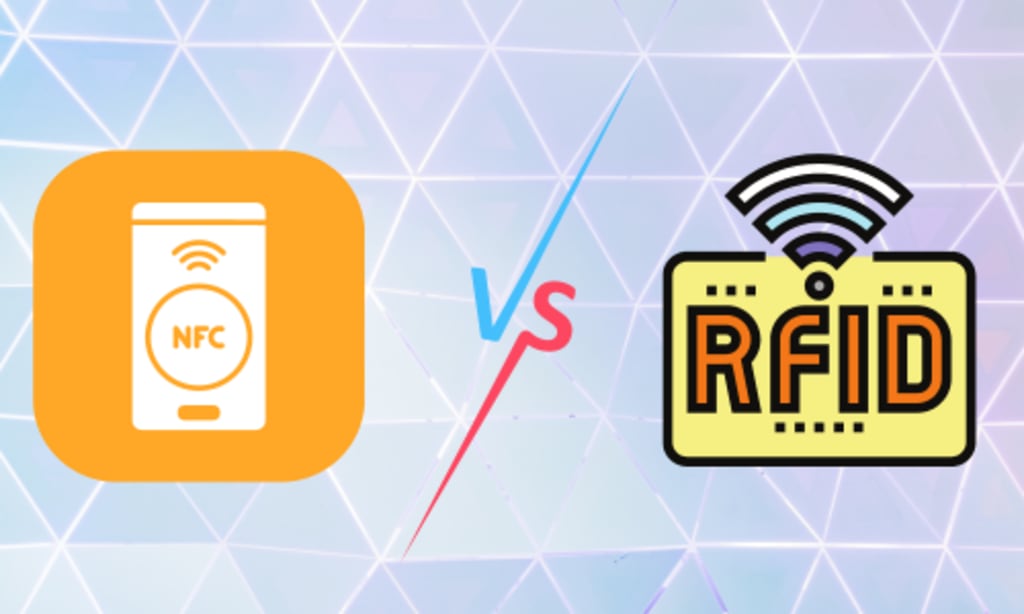RFID Technology vs. NFC: Understanding the Differences and Applications
Understanding these differences can help businesses and consumers decide which technology best suits their needs.

In today's technologically advanced world, RFID (Radio Frequency Identification) and NFC (Near Field Communication) are prominent technologies widely used for various applications, particularly in identification, tracking, and communication. While both technologies serve similar purposes, they have distinct differences that make them suitable for specific use cases. Understanding these differences can help businesses and consumers decide which technology best suits their needs.
What is RFID Technology?
RFID technology is designed to use electromagnetic fields to automatically identify and track tags attached to objects, which can be helpful. An RFID system comprises three main components: an RFID tag, an RFID reader, and an antenna. The RFID tag consists of a microchip and an antenna that transmits data to the RFID reader. RFID tags come in two forms: passive and active. Passive RFID tags have no internal power source and rely on the reader's electromagnetic field to power the chip, whereas active RFID tags have a battery that powers the chip and transmits signals.
Applications of RFID:
• Inventory Management: RFID tags are widely used in retail and warehousing to track inventory levels in real-time, reducing human error and improving accuracy.
• Supply Chain Management: RFID technology helps in tracking goods throughout the supply chain, ensuring transparency and efficiency.
• Access Control: Many organizations use RFID-based access control systems to secure their premises, allowing only authorized personnel to enter restricted areas.
• Asset Tracking: RFID tags are employed to track high-value assets, reducing loss and theft.
• Healthcare: In healthcare settings, RFID tags are used to monitor medical equipment and patient information, enhancing patient safety and operational efficiency.
What is NFC Technology?
NFC is a subset of RFID technology that operates at a high frequency (13.56 MHz) and allows for short-range communication, typically within a few centimeters. NFC technology involves two devices: an NFC reader (or writer) and an NFC tag or another NFC-enabled device. Unlike RFID, which can communicate over long distances, NFC requires the devices to be near each other.
Applications of NFC:
• Contactless Payments: NFC is the backbone of contactless payment systems such as Apple Pay, Google Wallet, and contactless credit cards, enabling secure and convenient transactions.
• Access Control: Similar to RFID, NFC is used for secure access control in buildings and public transportation systems.
• Data Transfer: NFC allows for quick data exchange between devices, such as sharing contacts, photos, or other files between smartphones.
• Smart Marketing: Businesses use NFC tags in marketing materials, allowing customers to tap their NFC-enabled devices to receive product information, discounts, or promotions.
Comparing RFID and NFC: Key Differences
1. Range of Communication:
o RFID: Depending on the type of RFID tag (passive or active), RFID systems can operate over varying ranges. Passive RFID tags typically have a range of a few meters, while active RFID tags can communicate over several hundred meters.
o NFC: NFC operates over a very short range, typically within a few centimeters. This proximity requirement enhances security for applications like contactless payments.
2. Power Source:
o RFID: Passive RFID tags do not have an internal power source and rely on the reader's electromagnetic field, whereas active RFID tags have a built-in battery.
o NFC: NFC tags are passive and powered by the electromagnetic field generated by the NFC reader or another NFC device.
3. Data Transfer Speed:
o RFID: Generally, RFID systems have lower data transfer speeds compared to NFC.
o NFC: NFC technology offers higher data transfer speeds, making it suitable for applications requiring quick data exchanges, such as contactless payments and data sharing between devices.
4. Security:
o RFID: While RFID systems can be secure, they are more susceptible to eavesdropping and interception due to their longer range. Security measures such as encryption can mitigate these risks.
o NFC: NFC's short range enhances its security, making it less susceptible to interception. This makes NFC particularly suitable for secure transactions and access control.
5. Cost:
o RFID: RFID systems can be more expensive to implement, especially for active RFID tags that require batteries and more complex infrastructure.
o NFC: NFC tags are generally cheaper and easier to deploy, as they do not require a power source and the readers are often integrated into smartphones and other devices.
Choosing Between RFID and NFC
The decision between RFID and NFC depends on the particular application and its requirements.:
• For Long-Range Tracking and Identification: RFID is ideal for applications like inventory management, supply chain logistics, and asset tracking due to its ability to communicate over longer distances.
• For Secure, Short-Range Communication: NFC is the preferred choice for applications requiring secure, close-proximity interactions, such as contactless payments, access control, and quick data transfers between devices.
Conclusion
Both RFID and NFC technologies offer unique advantages for various applications, and understanding their differences is crucial for selecting the right solution. RFID's ability to track items over long distances makes it indispensable for inventory and asset management, while NFC's secure, short-range communication is perfect for contactless payments and data sharing. By leveraging the strengths of each technology, businesses and consumers can enhance efficiency, security, and convenience in their operations and daily activities.
About the Creator
Enjoyed the story? Support the Creator.
Subscribe for free to receive all their stories in your feed. You could also pledge your support or give them a one-off tip, letting them know you appreciate their work.





Comments
There are no comments for this story
Be the first to respond and start the conversation.